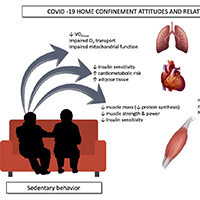When COVID-19 affects muscle: effects of quarantine in older adults

Submitted: 30 April 2020
Accepted: 16 May 2020
Published: 17 June 2020
Accepted: 16 May 2020
Abstract Views: 3114
PDF: 1131
HTML: 62
HTML: 62
Publisher's note
All claims expressed in this article are solely those of the authors and do not necessarily represent those of their affiliated organizations, or those of the publisher, the editors and the reviewers. Any product that may be evaluated in this article or claim that may be made by its manufacturer is not guaranteed or endorsed by the publisher.
All claims expressed in this article are solely those of the authors and do not necessarily represent those of their affiliated organizations, or those of the publisher, the editors and the reviewers. Any product that may be evaluated in this article or claim that may be made by its manufacturer is not guaranteed or endorsed by the publisher.
Similar Articles
- Sandra Zampieri, Ines Bersch, Piera Smeriglio, Elena Barbieri, Simona Boncompagni, Maria Chiara Maccarone, Ugo Carraro, Program with last minute abstracts of the Padua Days on Muscle and Mobility Medicine, 27 February – 2 March, 2024 (2024Pdm3) , European Journal of Translational Myology: Vol. 34 No. 1 (2024)
- Maurilio Sampaolesi, Stefania Fulle, Report and Abstracts of the 19th Meeting of the Interuniversity Institute of Myology: Assisi, October 20-23, 2022 , European Journal of Translational Myology: Vol. 33 No. 2 (2023)
- Sandra Zampieri, Ines Bersch, Piera Smeriglio, Elena Barbieri, Massimo Ganassi, Christiaan Leeuwenburg, Riccardo Rosati, Paolo Gargiulo, Amber Pond, H. Lee Sweeney, Ugo Carraro, Five Padua days on muscle and mobility medicine (2024Pdm3) 27 February - 2 March, 2024 at Hotel Petrarca, Thermae of Euganean Hills, Padua, and San Luca Hall, Prato della Valle, Padua, Italy , European Journal of Translational Myology: Vol. 33 No. 4 (2023)
- Nicola Manocchio, Isabella Iovene, Antonio Santoro, Maria Chiara Maccarone, Calogero Foti, Report and Abstracts of the 15th Congress of the Mediterranean Forum of Physical and Rehabilitation Medicine: Rome, July 6-8, 2023 , European Journal of Translational Myology: Vol. 33 No. 4 (2023)
- Robert Gerwin, Antonio Stecco, Carla Stecco, James Fricton, Summaries of the Padua symposium on myofascial pain, fibromyalgia, and fascial pain disorders, June 2023, Aula Falloppio at the Human Anatomy Institute of the University of Padova, Italy , European Journal of Translational Myology: Vol. 33 No. 4 (2023)
You may also start an advanced similarity search for this article.

 https://doi.org/10.4081/ejtm.2020.9069
https://doi.org/10.4081/ejtm.2020.9069



